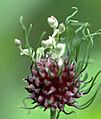Bulb facts for kids

A bulb is a special part of some plants. It usually grows underground. Think of it like a plant's pantry! It stores food for the plant when it's not actively growing. This helps the plant survive tough times, like cold winters or dry summers.
Many bulbs are used as food, like onions and garlic. Other bulbs are grown for their beautiful flowers, such as the lily, tulip, and some types of irises.
Some plant parts are similar to bulbs but have different names. These include tubers (like potatoes) and corms (swollen stems).
What is a Bulb?
A bulb is mostly made of thick, fleshy leaves called scales. These scales don't look like regular leaves. Instead, they are packed tightly together and hold lots of food for the plant. This stored food helps the plant stay alive when conditions are not good for growing.
At the very bottom of the bulb is a small, flat stem. This part is called the basal plate. All new growth comes from this basal plate. Roots grow downwards from the bottom of the basal plate. New stems and leaves grow upwards from the top.
How Bulbs Grow
Bulb plants have different stages of growth. First, they have a vegetative stage. During this time, the bulb grows bigger and stores more food. Then comes the reproductive stage, which is when the plant flowers.
Special things in nature, like the change from a cold winter to a warm spring, tell the bulb when to switch from one stage to the next.
After the flowers bloom, the plant enters a foliage period. This usually lasts about six weeks. During this time, the plant uses its leaves to absorb nutrients from the dirt and energy from the sun. This energy is used to prepare the flowers for the next year. If a bulb is dug up before this foliage period is over, it might not bloom the following year. But it should flower normally in the years after that.
Images for kids
-
Shallot bulbs
-
Small bulbs called bulbils can grow in the leaf corners of Lilium lancifolium.
-
"Tree onions" grow clusters of small bulbs instead of flowers.
See also
 In Spanish: Bulbo (botánica) para niños
In Spanish: Bulbo (botánica) para niños








